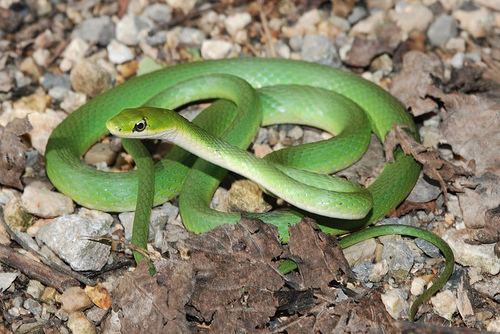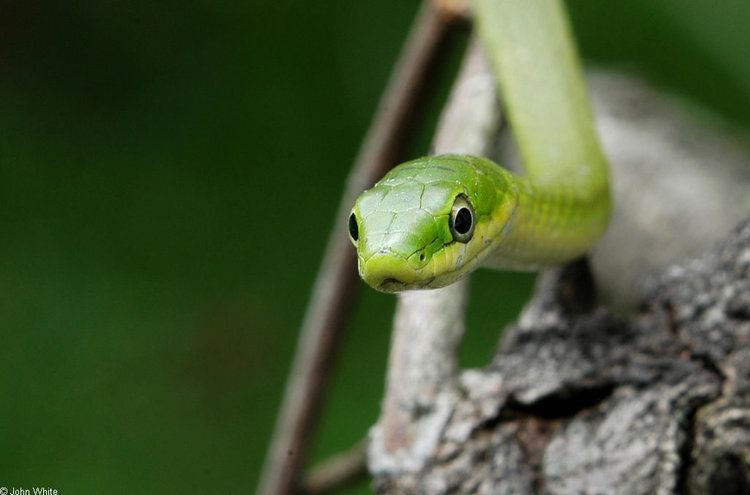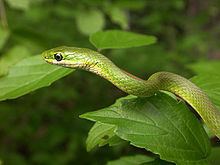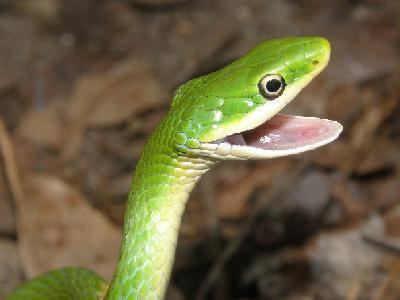Subphylum Vertebrata Suborder Serpentes Rank Species | Phylum Chordata Higher classification Opheodrys | |
 | ||
Similar Opheodrys, Snake, Reptile, Smooth green snake, Coluber constrictor | ||
Opheodrys aestivus, commonly known as the rough green snake, is a nonvenomous North American colubrid. It is sometimes called grass snake or green grass snake, but these names are more commonly applied to the smooth green snake (Opheodrys vernalis). The European colubrid called grass snake (Natrix natrix) is unrelated. The rough green snake is docile, often allowing close approach by humans, and seldom bites. Even when bites occur, they have no venom and are harmless.
Contents
- Rough green snake
- Description
- Geographic range
- Habitat and behavior
- Diet
- Predation
- Reproduction
- Conservation status
- Subspecies
- References

Rough green snake
Description

The rough green snake (Opheodrys aestivus) is bright green above and has a yellowish belly, affording it excellent camouflage in green vegetation. It has keeled dorsal scales, which are arranged in 17 rows at midbody. It grows up to 116 cm (45 3⁄4 in) in total length (including tail) and is very thin.
Geographic range

The rough green snake ranges throughout the Southeastern United States, from Florida, north to New Jersey, Indiana, and west to Central Texas. The snake is commonly found in the Piedmont and Atlantic coastal plain, but is not found in the higher elevations of the Appalachian Mountains. It is also found in northeastern Mexico, including the state of Tamaulipas and eastern Nuevo León.
Habitat and behavior

The preferred habitat of O. aestivus is moist meadows and woodlands, often near water. It is highly arboreal, frequently found climbing in low vegetation, and is also a good swimmer. However, it is often found on the ground as well. Unlike many snakes, it is largely diurnal.
Diet

The diet of O. aestivus consists mostly of insects and other terrestrial arthropods, but some snails and tree frogs are eaten as well. This snake is not a constrictor; most prey are grabbed and simply swallowed alive.
Predation

Predators of the rough green snake include birds and other snakes, such as the eastern racer (Coluber constrictor) and the eastern king snake (Lampropeltis getula).
Reproduction
The rough green snake breeds in spring, and sometimes again in fall. Females lay 2-14 eggs, occasionally in a communal nest shared by more than one female. Up to 75 eggs have been found in one such nest. The nest site varies: under boards, under bark in rotting stumps, in deep mulch, or under a rock. Hatchlings from spring breeding typically emerge in August or September, and each is about 18–20 cm (7.1–7.9 in) in total length.
Conservation status
The rough green snake is widespread and is not of conservation concern, in general. However, urban development, especially the reduction of vegetation near waterways, may reduce their numbers. Many are killed on roads, and they may be susceptible to poisoning by pesticides used on their insect prey. When dead, they turn blue. It is also one of the most exploited pet snakes in North America. O. aestivus are collected by the hundreds each year and wholesale for around eight dollars in U.S. currency making it a very accessible species to pet shops and later to the pet owner.
